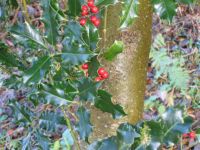English Holly - Ilex aquifolium
English name:
English Holly
Scientific name:
Ilex aquifolium
Family:
Aquifoliaceae (Holly)
Height:
16 M in Denmark
Flowering:
May
Range:
western and southern Europe, North Africa, Caucasus
 |
 |
 |
The 68 year-old Ilex aquifolium in the pictures is from seed collected in the Forest Botanic Garden in Charlottenlund, Denmark. This holly can be found south of the maple collection square 1408, position 2118. A map with squares and positions can be found on our homepage under: Digital plant search of the Arboretum or at our entrance sign.
Plant description:
The genus Ilex contains between 400 and 800 species depending of what book one reads. The reason for the large difference of opinion may be because of the many natural hybrids. Like rhododendrons the genus seems to be rather dynamic with hybrids readily forming between species and they seem to mutate easily which has resulted in may fine cultivars. Ilex is a widely distributed genus occurring in temperate to tropical zones of all continents except for Antarctica and Australia. We have only 10 species in our collection, in spite of the fact that we have tested 53 species over the years.
I. aquifolium is native to western Denmark and coastal Norway where it reaches it northern limit. It is the only evergreen broadleaf tree to grow naturally in the Nordic countries. It is now found regenerating from garden plants in much of Denmark. It has been regenerating from seed for many decades in the Forest Botanical Garden in Charlottenlund and it is now doing the same in the Arboretum. Here one can find self-sown seedlings scattered in areas where grass is not a competitor, for example under beech trees and even under the dense shade of Taxus baccata. This invasion of the species to new areas may be the result of our warmer wetter winters of the recent years. We have 23 registered examples of I. aquifolium in our collection and many unregistered self sown seedlings.
I. aquifolium readily forms new shoots from stumps and this may help it to survive the coldest winters when it might be strongly damaged, but then re-sprouts. Our oldest registered example was planted around 1840 in the Forest Botanic Garden. It was cut down in 1945, only to send up a new set of new shoots from the stump.
Ilex aquifolium is an evergreen, tree with a conical form when young, and an irregular dense crown with hanging branches when older. The alternately placed evergreen leaves can vary from being strongly toothed with spines in juvenile foliage, to having a smooth margins without teeth in foliage found above the normal browsing height of animals. The foliage is dark shinny green on the upper surface and mat light-green underneath. The bark is smooth and light grey however, large warts can be found. Flower buds are tightly grouped in the axels of the leaves. Flowering occurs in May with groups of small white fragrant female or male flowers. Female and male flowers occur on separate trees. The fruit is a red, berry-like drup, which means the seed is inside a hard shell which is inside a fleshy layer. The hard shell allows the seed to pass through the gut of birds unharmed, but often delays germination. The fruit can remain on the tree for the whole winter if not eaten by birds. Blackbirds are often seen flying out of our holly trees this time of the year when they are disturbed by curious dendrologists.
This is a well known and strikingly tree with a history in folklore dating back at least to the Roman times. It is worthwhile for the garden providing Christmas decoration as well as brightening up the garden during the darkest months with its red fruit and evergreen leaves. Both male and female trees are needed in order to get fruit development, but fine cultivars of both sexes exist. The species responds well to clipping and can be used for hedges, formally clipped bushes and even espaliers up the side of the house
References:
Bean, W.J. 1973. Trees and Shrubs Hardy in the British Isles Vol II. D-M. Bean and Murray publishers. 784 pp.
Galle, F.C. 1997. Hollies The Genus Ilex. Timber Press, Portland Oregon. 537 pp.
Mabberley, D.J. 1998. The Plant Book. The Bath Press, Bath, 858 pp.
Mitchell, A. & Ødum S. 1983. Træer i Nordeuropa (Trees in Northern Europe). Gads Forlag, Copenhagen, pp. 413pp.
Møller, P.F. & Staun, H. 2001. Danmarks Træer og buske (Denmarks Trees and Bushes). Politikens Forlag A/S, Copenhagen, 336 pp.
Olsen, O. et al. 1997 Havens Planteleksikon. Træer og Buske. (Danish Plant Encyclopaedia, Trees & Bushes). Det Danske Haveselskab Publisher, 674 pp.
Rushforth, K. 1999. Trees of Britain and Europe. Harper Collins Publisher. 1336 pp.
